Lunar Terrestrial Analog Experiment on the Spectral Interpretations of Rocks Observed by the Yutu-2 Rover
Abstract
:1. Introduction
2. Sample Description and Analytical Methods
2.1. Sample Description
2.2. Backscattered Electron Imaging
2.3. Ground Spectroscopic Verification Experiment
2.4. Data Processing Methods
3. Results
3.1. Scanning Electron Microscopy Results
3.2. VNIS Results
3.2.1. Laboratory Rock Sample (CR-1)
3.2.2. Mineral Abundance Derived from the Spectral Unmixing Model
3.2.3. Chang’e-4 Spectral Data (Lunar Rock)
4. Discussion
4.1. Error and Correction of Verification Experiment
4.2. Spectral Comparison of CR-1 and Chang’e-4 Rock
4.3. Application of Hapke Radiative Transfer Model to the Chang’e-4 Rock Type
5. Conclusions
Supplementary Materials
Author Contributions
Funding
Data Availability Statement
Acknowledgments
Conflicts of Interest
References
- Li, C.L.; Wang, Z.D.; Xu, R.; Lv, G.; Yuan, L.Y.; He, Z.P.; Wang, J.Y. The Scientific Information Model of Chang’e-4 Visible and Near-IR Imaging Spectrometer (VNIS) and In-Flight Verification. Sensors 2019, 19, 2806. [Google Scholar] [CrossRef] [PubMed] [Green Version]
- Jia, Y.Z.; Zou, Y.L.; Ping, J.S.; Xue, C.B.; Yan, J.; Ning, Y.M. The scientific objectives and payloads of Chang’E-4 mission. Planet Space Sci. 2018, 162, 207–215. [Google Scholar] [CrossRef]
- Pieters, C.M.; Head, J.W.; Gaddis, L.; Jolliff, B.; Duke, M. Rock types of South Pole-Aitken basin and extent of basaltic volcanism. J. Geophys. Res.Planet 2001, 106, 28001–28022. [Google Scholar] [CrossRef]
- Moriarty, D.P.; Pieters, C.M. The Character of South Pole-Aitken Basin: Patterns of Surface and Subsurface Composition. J. Geophys. Res. Planet 2018, 123, 729–747. [Google Scholar] [CrossRef]
- Huang, J.; Xiao, Z.Y.; Flahaut, J.; Martinot, M.; Head, J.; Xiao, X.; Xie, M.G.; Xiao, L. Geological Characteristics of Von Karman Crater, Northwestern South pole-Aitken Basin: Chang’E-4 Landing Site Region. J. Geophys. Res. Planet 2018, 123, 1684–1700. [Google Scholar] [CrossRef] [Green Version]
- Qiao, L.; Ling, Z.H.; Fu, X.H.; Li, B. Geological characterization of the Chang’e-4 landing area on the lunar farside. Icarus 2019, 333, 37–51. [Google Scholar] [CrossRef]
- Lin, H.; He, Z.; Yang, W.; Lin, Y.; Xu, R.; Zhang, C.; Zhu, M.H.; Chang, R.; Zhang, J.; Li, C.; et al. Olivine-norite rock detected by the lunar rover Yutu-2 likely crystallized from the SPA-impact melt pool. Natl. Sci. Rev. 2020, 7, 913–920. [Google Scholar] [CrossRef] [Green Version]
- Ling, Z.C.; Qiao, L.; Liu, C.Q.; Cao, H.J.; Bi, X.Y.; Lu, X.J.; Zhang, J.; Fu, X.H.; Li, B.; Liu, J.Z. Composition, mineralogy and chronology of mare basalts and non-mare materials in Von Karman crater: Landing site of the Chang’E-4 mission. Planet Space Sci. 2019, 179, 4741. [Google Scholar] [CrossRef]
- Li, C.L.; Liu, D.W.; Liu, B.; Ren, X.; Liu, J.J.; He, Z.P.; Zuo, W.; Zeng, X.G.; Xu, R.; Tan, X.; et al. Chang’E-4 initial spectroscopic identification of lunar far-side mantle-derived materials. Nature 2019, 569, 378. [Google Scholar] [CrossRef]
- Hu, X.Y.; Ma, P.; Yang, Y.Z.; Zhu, M.H.; Jiang, T.; Lucey, P.G.; Sun, L.Z.; Zhang, H.; Li, C.L.; Xu, R.; et al. Mineral Abundances Inferred from In Situ Reflectance Measurements of Chang’E-4 Landing Site in South Pole-Aitken Basin. Geophys. Res. Lett. 2019, 46, 9439–9447. [Google Scholar] [CrossRef]
- Gou, S.; Yue, Z.Y.; Di, K.C.; Wang, J.; Wan, W.H.; Liu, Z.Q.; Liu, B.; Peng, M.; Wang, Y.X.; He, Z.P.; et al. Impact melt breccia and surrounding regolith measured by Chang’e-4 rover. Earth Planet Sci. Lett. 2020, 544, 6378. [Google Scholar] [CrossRef]
- Zeng, Q.; Chen, S.; Zhang, Y.; Mu, Y.; Dai, R.; Yang, C.; Li, A.; Lu, P. Mineralogical and chemical properties inversed from 21-lunar-day VNIS observations taken during the Chang’E-4 mission. Sci. Rep. 2021, 11, s41598–s42021. [Google Scholar]
- Clark, R.N.; Roush, T.L. Reflectance Spectroscopy–Quantitative-Analysis Techniques for Remote-Sensing Applications. J. Geophys. Res. 1984, 89, 6329–6340. [Google Scholar] [CrossRef]
- Hapke, B. Bidirectional Reflectance Spectroscopy. Theory. J. Geophys. Res. 1981, 86, 3039–3054. [Google Scholar] [CrossRef]
- Lin, H.L.; Xu, R.; Yang, W.; Lin, Y.T.; Wei, Y.; Hu, S.; He, Z.P.; Qiao, L.; Wan, W.X. In Situ Photometric Experiment of Lunar Regolith with Visible and Near-Infrared Imaging Spectrometer on Board the Yutu-2 Lunar Rover. J. Geophys. Res. Planet 2020, 25, 76. [Google Scholar] [CrossRef]
- Gu, L.X.; Hu, S.; Anand, M.; Tang, X.; Ji, J.L.; Zhang, B.; Wang, N.; Lin, Y.T. Occurrence of tuite and ahrensite in Zagami and their significance for shock-histories recorded in Martian meteorites. Am. Miner. 2022, 17, 564. [Google Scholar]
- Lin, H.L.; Yang, Y.Z.; Lin, Y.T.; Liu, Y.; Wei, Y.; Li, S.; Hu, S.; Yang, W.; Wan, W.H.; Xu, R.; et al. Photometric properties of lunar regolith revealed by the Yutu-2 rover. Astron. Astrophys. 2020, 638, 7859. [Google Scholar] [CrossRef]
- Sunshine, J.M.; Pieters, C.M.; Pratt, S.F.; McNaron-Brown, K.S. Absorption Band Modeling in Reflectance Spectra: Availability of the Modified Gaussian Model. In Proceedings of the 30th Lunar and Planetary Science Conference, Houston, TX, USA, 15–29 March 1999; p. 1306. [Google Scholar]
- Lin, H.L.; Li, S.; Lin, Y.T.; Liu, Y.; Wei, Y.; Yang, W.; Yang, Y.Z.; Hu, S.; Wu, X.; Xu, R.; et al. Thermal Modeling of the Lunar Regolith at the Chang’E-4 Landing Site. Geophys. Res. Lett. 2021, 48, 1687. [Google Scholar] [CrossRef]
- Kanner, L.C.; Mustard, J.F.; Gendrin, A. Assessing the limits of the Modified Gaussian Model for remote spectroscopic studies of pyroxenes on Mars. Icarus 2007, 187, 442–456. [Google Scholar] [CrossRef]
- Gou, S.; Di, K.C.; Yue, Z.Y.; Liu, Z.Q.; He, Z.P.; Xu, R.; Lin, H.L.; Liu, B.; Peng, M.; Wan, W.H.; et al. Lunar deep materials observed by Chang’e-4 rover. Earth Planet Sci. Lett. 2019, 528, 5829. [Google Scholar] [CrossRef]
- Streckeisen, A. Classification and Nomenclature of Plutonic Rocks. Rocks Geo. Times 1973, 18, 26–30. [Google Scholar]
- Stoeffler, D.; Knoell, H.D.; Marvin, U.B.; Simonds, C.H.; Warren, P.H. Recommended classification and nomenclature of lunar highland rocks–A committee report. In Proceedings of the Conference on the Lunar Highlands Crust, Houston, TX, USA, 14–16 November 1979; pp. 51–70. [Google Scholar]
- Heiken, G.; French, B. Lunar Sourcebook: A User’s Guide to the Moon; Cambridge University Press: Cambridge, UK, 1991; pp. 357–474. [Google Scholar]
- Klima, R.L.; Pieters, C.M.; Boardman, J.W.; Green, R.O.; Head, J.W.; Isaacson, P.J.; Mustard, J.F.; Nettles, J.W.; Petro, N.E.; Staid, M.I.; et al. New insights into lunar petrology: Distribution and composition of prominent low-Ca pyroxene exposures as observed by the Moon Mineralogy Mapper (M-3). J. Geophys. Res. Planet 2011, 116, 3719. [Google Scholar] [CrossRef]
- Yang, Y.Z.; Lin, H.L.; Liu, Y.; Lin, Y.T.; Wei, Y.; Hu, S.; Yang, W.; Xu, R.; He, Z.P.; Zou, Y.L. The Effects of Viewing Geometry on the Spectral Analysis of Lunar Regolith as Inferred by in situ Spectrophotometric Measurements of Chang’E-4. Geophys. Res. Lett. 2020, 47, 80. [Google Scholar] [CrossRef]
- Liu, C.; Liu, L.; Chen, J.; Cao, H.; Qu, H.; Qiao, L.; Zhang, J.; Qi, X.; Lu, X.; Xu, R.; et al. Mafic mineralogy assemblages at the Chang’e-4 landing site: A combined laboratory and lunar in situ spectroscopic study. Astron. Astrophys. 2022, 658, 1398. [Google Scholar] [CrossRef]
- Lucey, P.G. Model near-infrared optical constants of olivine and pyroxene as a function of iron content. J. Geophys. Res. Planet 1998, 103, 1703–1713. [Google Scholar] [CrossRef]
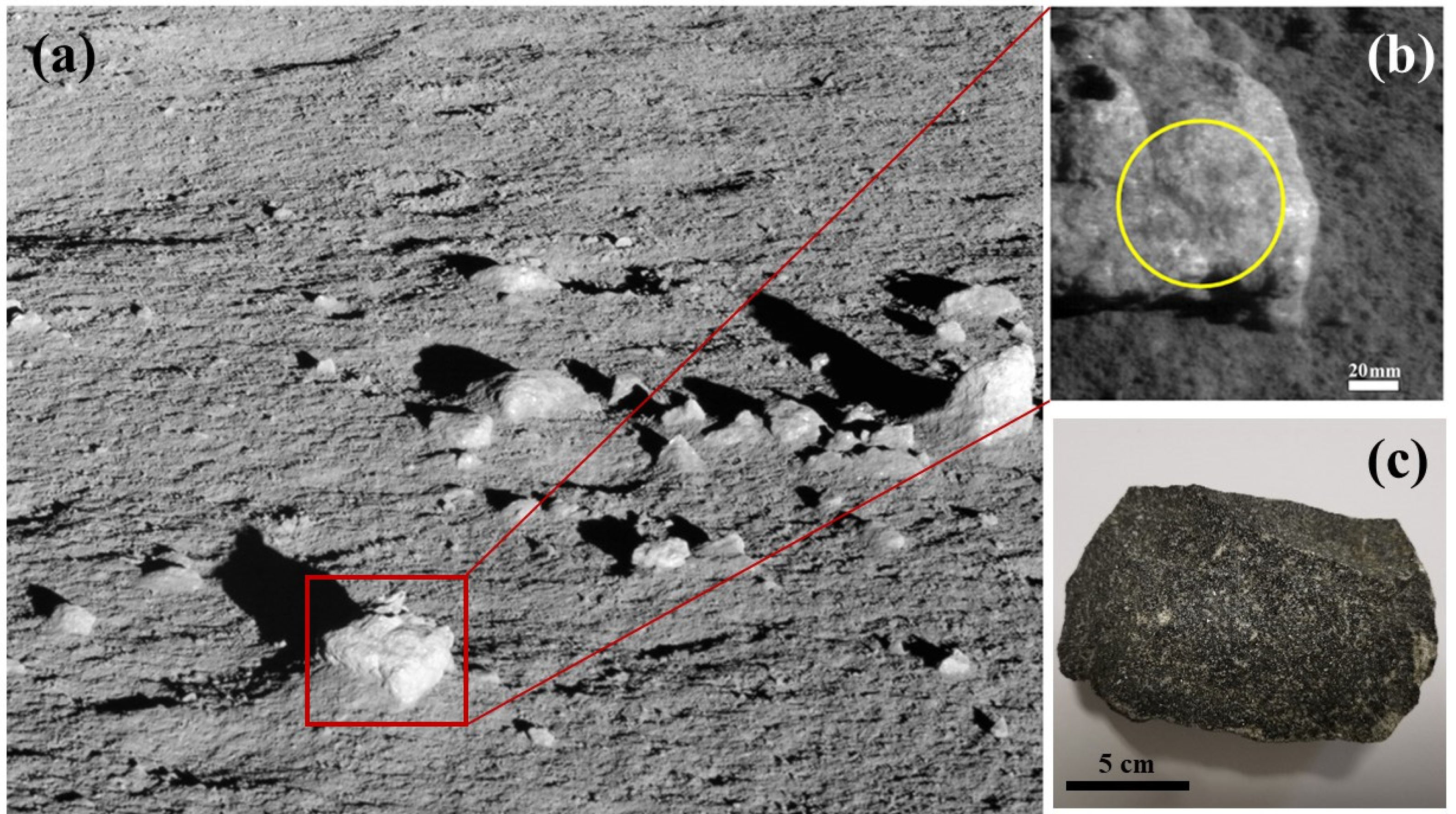

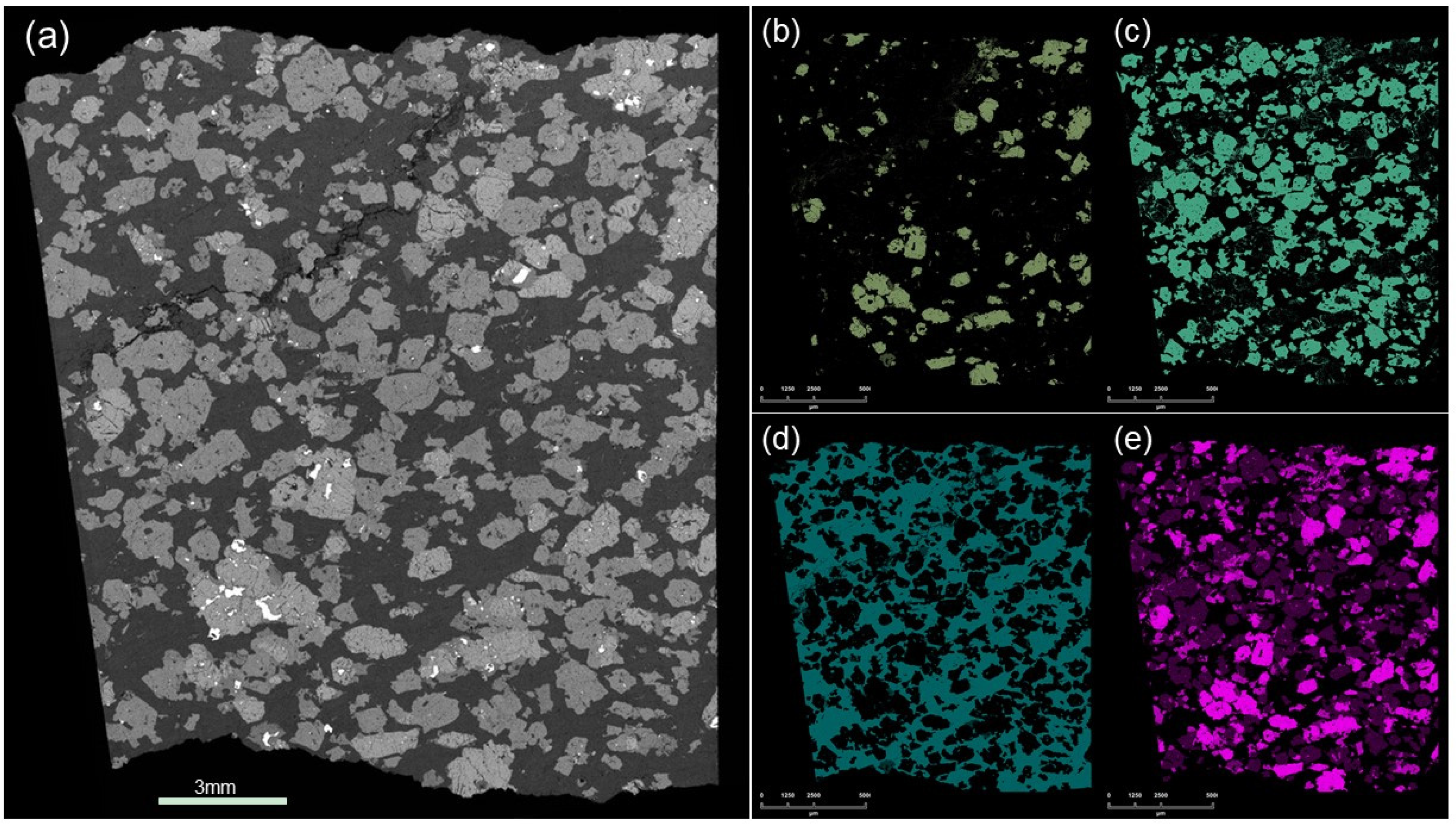


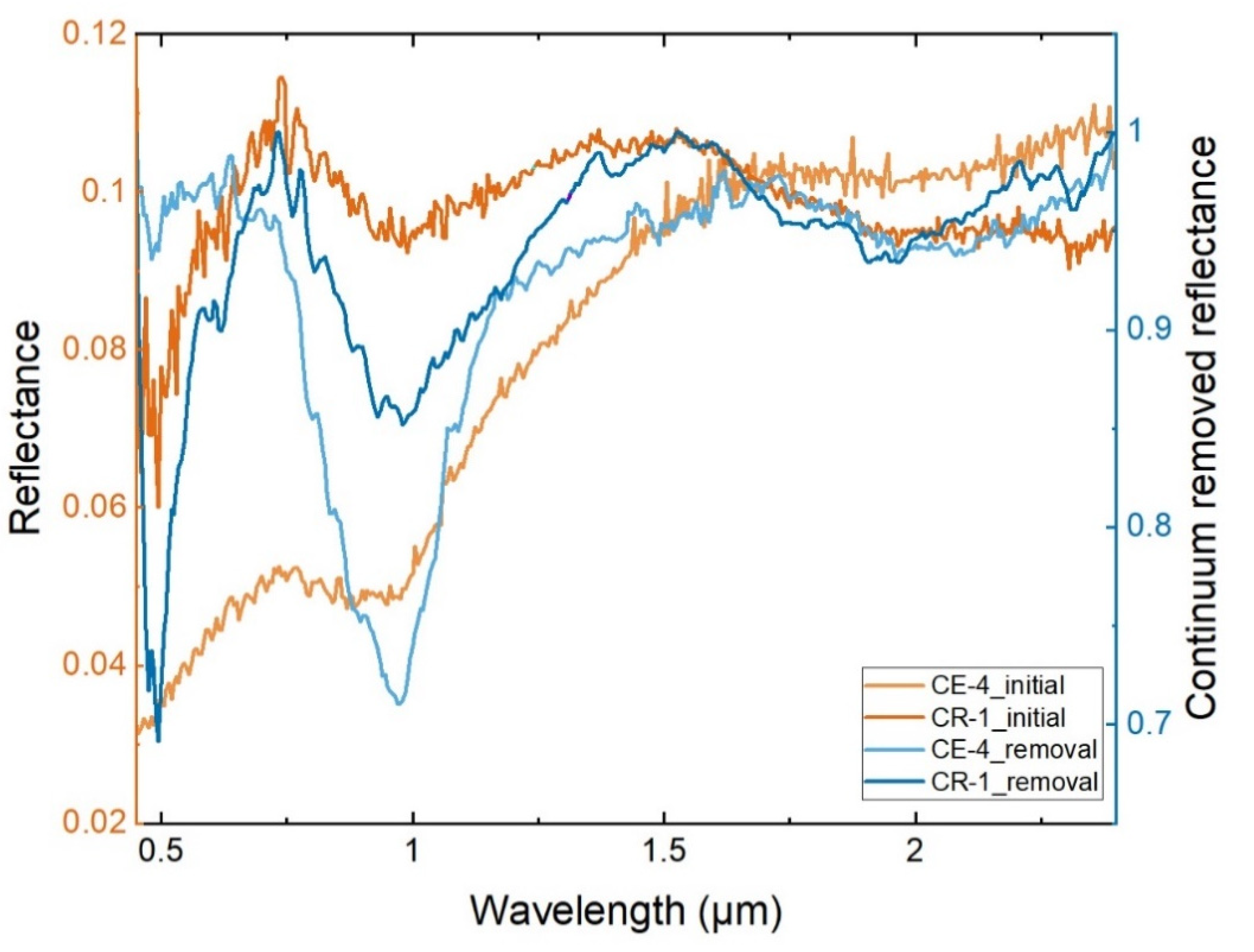
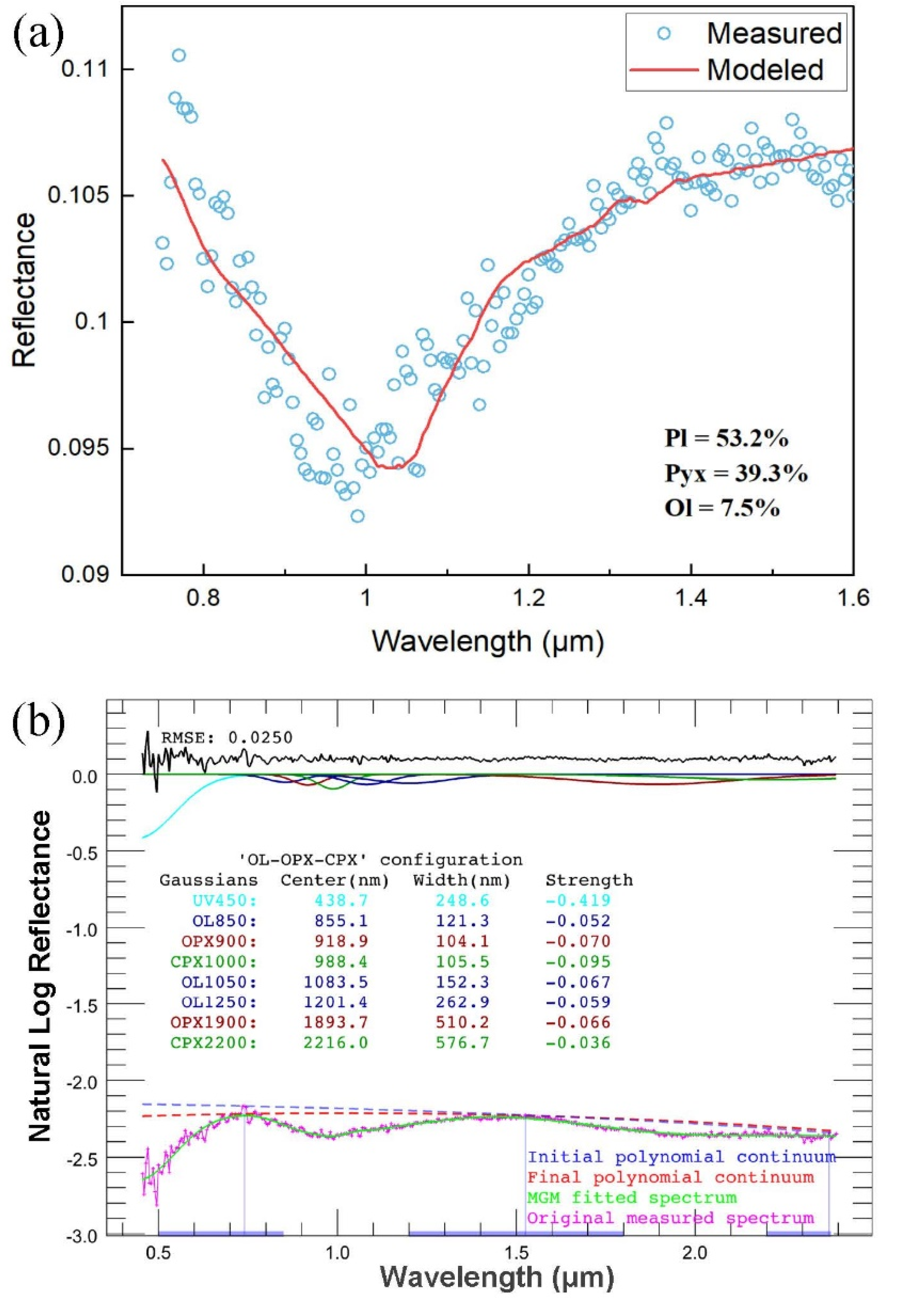
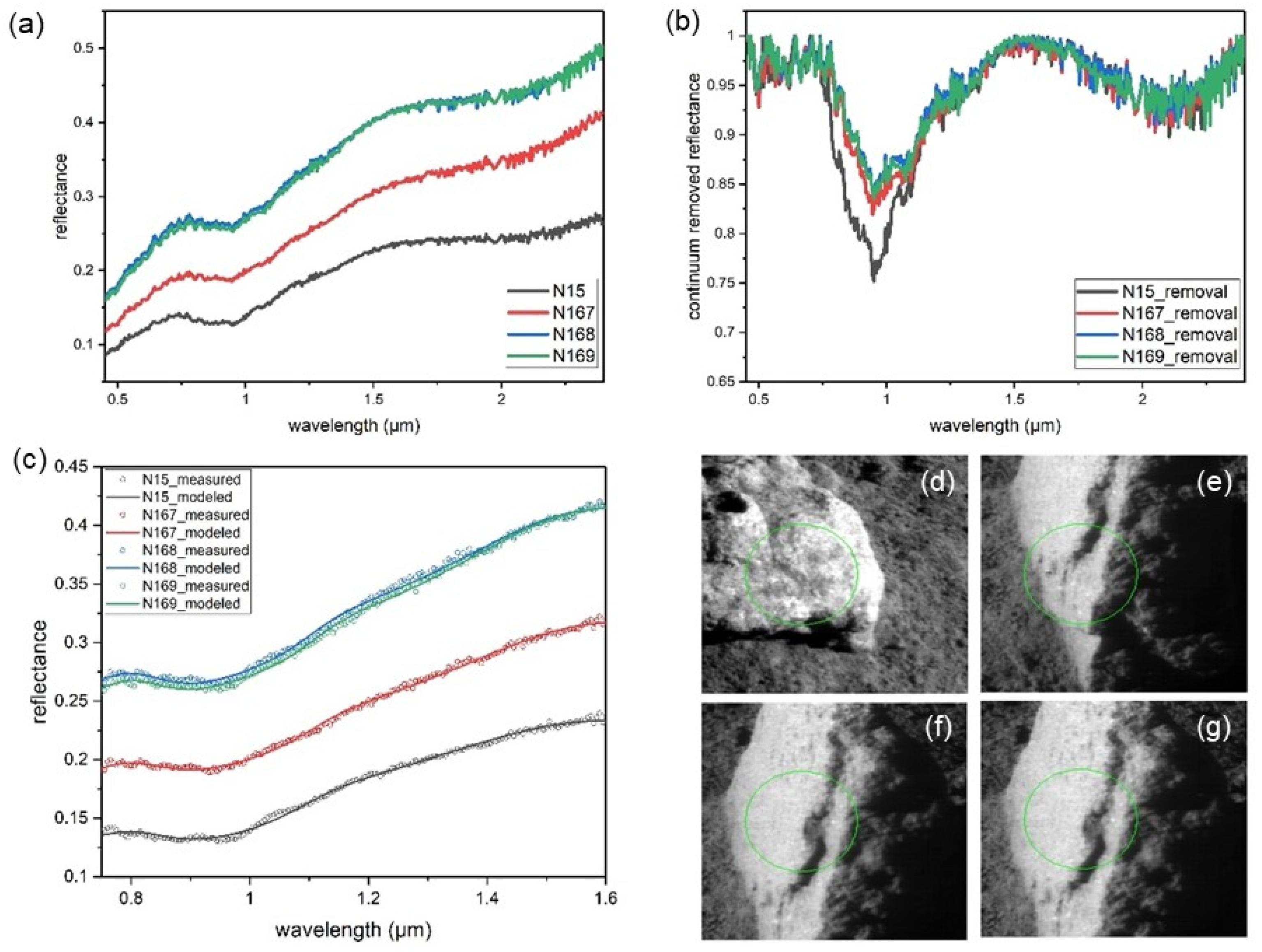
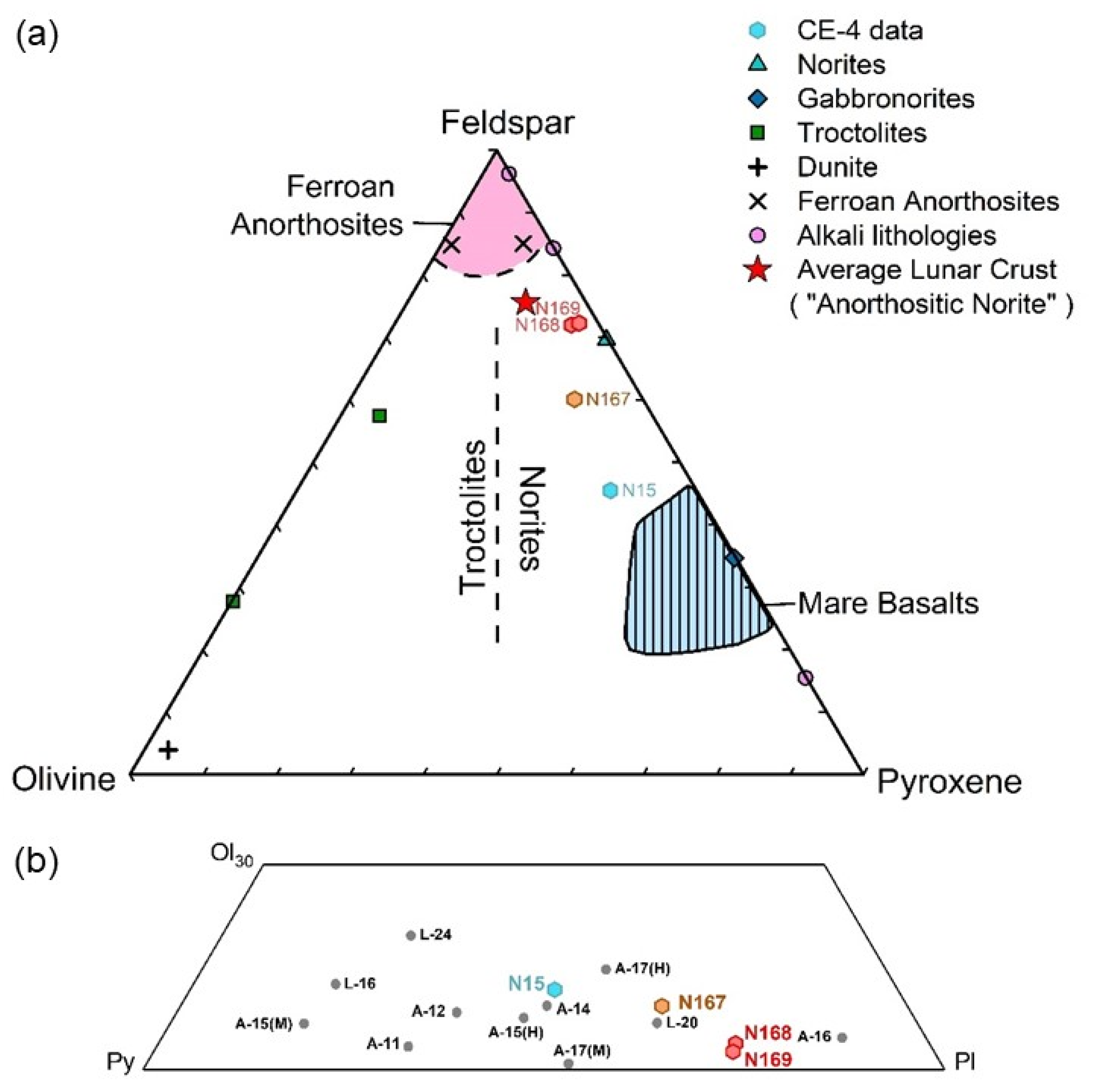
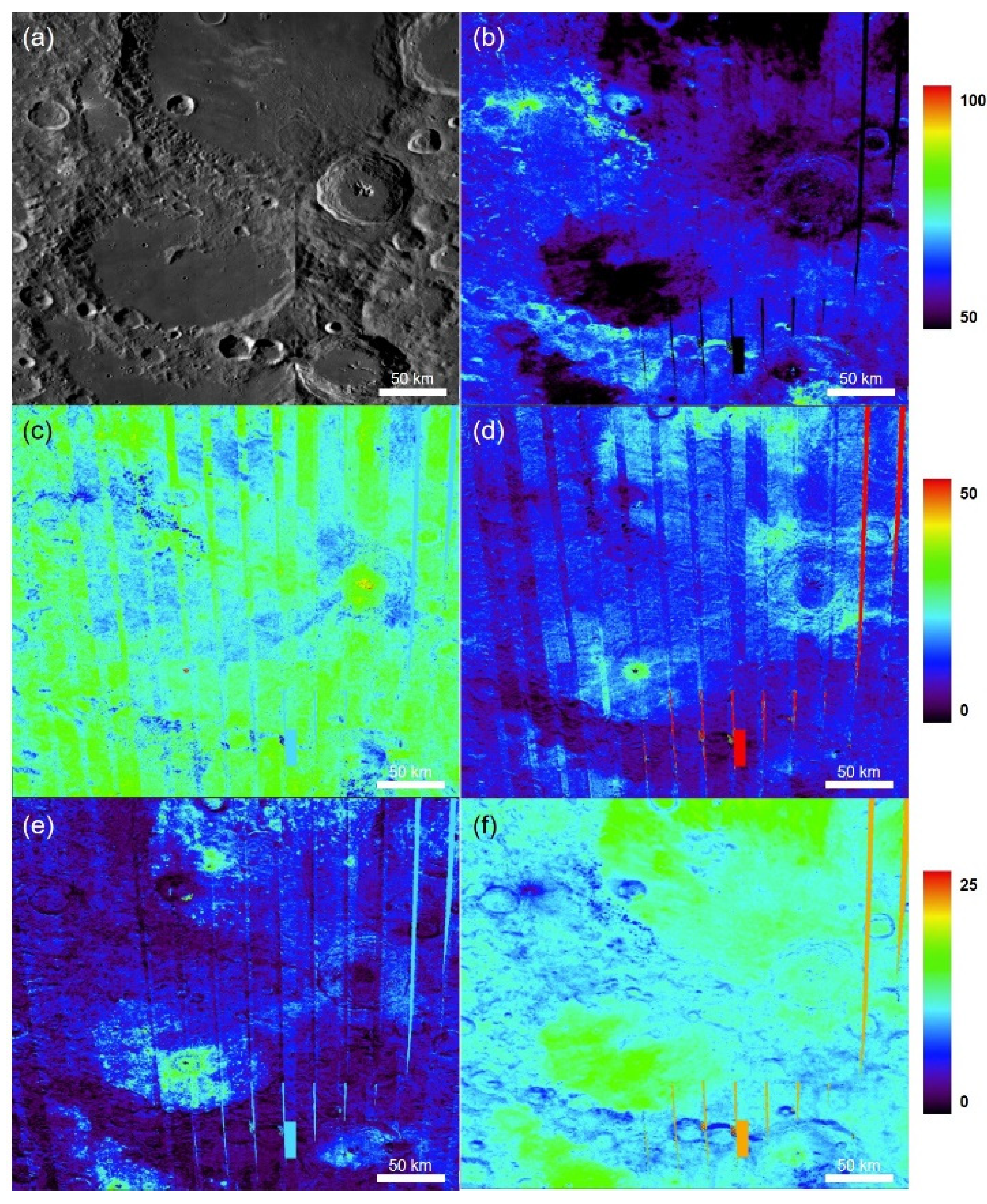
| Number | Hapke Model | Modified Gaussian Model | ||||||
|---|---|---|---|---|---|---|---|---|
| Particle | Pyx | Olv | Plg | SMFe | Olv | Opx | Cpx | |
| Size (μm) | (wt%) | (wt%) | (wt%) | (wt%) | (wt%) | (wt%) | ||
| N15 | 80 | 42.8 | 11.7 | 45.5 | 0.07% | 0.31 | 0.30 | 0.40 |
| N167 | 80 | 30.6 | 9.3 | 60.1 | 0.05% | 0.35 | 0.28 | 0.37 |
| N168 | 80 | 24.2 | 3.8 | 72.0 | 0.04% | 0.36 | 0.26 | 0.37 |
| N169 | 80 | 25.1 | 2.6 | 72.3 | 0.04% | 0.35 | 0.28 | 0.37 |
Publisher’s Note: MDPI stays neutral with regard to jurisdictional claims in published maps and institutional affiliations. |
© 2022 by the authors. Licensee MDPI, Basel, Switzerland. This article is an open access article distributed under the terms and conditions of the Creative Commons Attribution (CC BY) license (https://creativecommons.org/licenses/by/4.0/).
Share and Cite
Chang, R.; Yang, W.; Lin, H.; Xu, R.; Gou, S.; Wang, R.; Lin, Y. Lunar Terrestrial Analog Experiment on the Spectral Interpretations of Rocks Observed by the Yutu-2 Rover. Remote Sens. 2022, 14, 2323. https://doi.org/10.3390/rs14102323
Chang R, Yang W, Lin H, Xu R, Gou S, Wang R, Lin Y. Lunar Terrestrial Analog Experiment on the Spectral Interpretations of Rocks Observed by the Yutu-2 Rover. Remote Sensing. 2022; 14(10):2323. https://doi.org/10.3390/rs14102323
Chicago/Turabian StyleChang, Rui, Wei Yang, Honglei Lin, Rui Xu, Sheng Gou, Rong Wang, and Yangting Lin. 2022. "Lunar Terrestrial Analog Experiment on the Spectral Interpretations of Rocks Observed by the Yutu-2 Rover" Remote Sensing 14, no. 10: 2323. https://doi.org/10.3390/rs14102323






